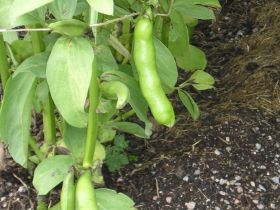Broad Beans
Broad beans, or fava beans as they are sometimes called, are a versatile and delicious vegetable. Rich in protein and vitamin C, they are a popular vegetable plot favourite. Some broad beans are especially good for overwintering – planted in autumn and protected against the frost, broad bean varieties like Aquadulce Claudia can give a yield as early as May, while other varieties are better suited to spring planting.
Growing Broad Beans:
Broad beans planted in autumn in a cold frame or polytunnel or under cloches can be the first vegetable to plug the 'hungry gap' in the vegetable gardener's year. Those planted in spring without shelter can also be a useful addition to any garden. Broad beans typically have pods containing between four and eight beans, depending on varietal. They like a sunny spot, though will grow fine in partial shade. They like soil which is rich, moisture retentive and yet free draining. You can prepare the site prior to planting by adding leaf mould or well-rotted manure.
Broad beans can be planted directly into the soil, but germination, especially for early sowings, can be more reliable if you plant undercover and transplant seedlings to their final position. Broad beans can be started off in toilet roll tubes or biodegradable plant pots, which can then be planted with the seedling into the soil. This can give you a jump start on the season if later frosts are expected and will also help if you have trouble with mice eating your beans.
Do not be tempted to plant broad beans too close together. They need good airflow around them to avoid fungal diseases. Stake plants with sticks or bamboo canes to prevent the stems from breaking. Try to avoid planting beans in a very windy spot.
Broad beans should be watered very thoroughly when flowers appear and again a week or two later. When the first bean pods appear at the bottom of the plant, pinch out the growing tips. Don't throw the tips away – they are delicious steamed or in a stir-fry.
Broad beans are fully mature when the pods burst open, but for the tastiest beans, harvest when beans are still quite small. Broad beans are easy to store. They can be frozen or dried for eating over winter or planting next year. Broad beans should be cooked before they are eaten.
Why Grow Broad Beans in the garden?
Like all other legumes, broad beans are able, along with helpful bacteria in their roots, to take nitrogen from the air and fix it in the soil. When the harvest is done, leave the roots in place and they will act as a fertiliser for whatever you plant there next.
Broad beans are also extremely healthy and relatively easy to grow. Kids will love splitting open the pods to see the broad beans sleeping in their blankety beds.
